 |
| Merle Little and one of his Morgan horses at El Rancho Poco. |
Merle Hartley Little (1906-1975) was one of
the leading horsemen in Southern California from the 1930s through the mid-1970s. His "El Rancho Poco" in Monrovia/Duarte was well-known throughout Southern California not only for its horses, but also as an important part of community life.
 |
| Merle and some of his Morgan horses, 1965 |
Affiliated with numerous civic and equestrian groups, Merle achieved local,
regional, and national attention for his use of horses to build community,
fostering shared experiences and a sense of belonging for people in Monrovia,
Duarte, and beyond.
%20Lippitt%20parade%20flag.jpg) |
Carrying the American flag, Merle Little rides his Morgan stallion
Lippitt Morman with the Monrovia Mounted Police, circa 1950s |
Horses were still a part of suburban and agricultural life during Merle Little's lifetime. Even though their importance as a means of transportation and labor decreased with the advent of motorized vehicles, Merle still viewed horses as an important part of community life. The Pasadena Post's July 19, 1932 edition quoted Merle as saying he believed that horses were "coming into their own again."
Merle's involvement in equestrian activities during the Great Depression illustrated Southern Californians' interest in horseback riding for pleasure. Even though motorized vehicles increasingly replaced horses and mules in transportation and agriculture after World War I, the number of privately-owned riding horses and ponies gradually went up as more people used them as a form of recreation, whether by owning a horse or renting one. A number of factors influenced the popularity of the saddle horse during Merle's adult lifetime. From the 1930s through the mid-1960s, radio, film, and television cowboys and their horses were as popular then, as "Star Wars" or the Marvel Universe are today. Children took riding lessons and dreamed of owning their own horses or ponies. Newspaper coverage demonstrates that horse shows were held basically every weekend in LA County; parades and rodeos celebrated every major holiday. Pasadena's Tournament of Roses Parade, the Santa Barbara Fiesta Parade, Azusa Golden Days, and Monrovia Day, each attracted hundreds of horses and riders in parades and horse shows. Take a good community gathering, add horses and riders, and it's even more interesting, entertaining, and memorable.
Local governments and equestrians worked together to develop networks of riding trails up and down the state. Businessmen would dress in Western wear and go horseback riding in groups back then, the way they take part in golf tournaments now. Until 1948, the US Army's Remount program bred horses for war, and encouraged horse owners to breed their mares to Government stallions. (The Army's Pomona Remount Depot was located on the site of W. K. Kellogg's Arabian Horse Ranch; now, that land is Cal Poly Pomona.)
The 1949-1950 Los Angeles County Horseman's Directory (a copy of which Merle saved) published the names and addresses of more than 4,000 horse owners, as well as those of veterinarians, farriers, boarding and training stables, and other related businesses like feed and tack stores. (This did not include the Thoroughbred racehorses at Santa Anita or Hollywood Park.) There were more than 50 horse owners identified in Monrovia and Duarte, and hundreds more in the rest of the San Gabriel and Pomona Valleys.
In short, Merle Little and his horses were in the right place at the right time.
Early Life: A native of Monrovia, Merle was born
October 21, 1906, the son of Arthur J. and Emma E. (Shields) Little. His
father, an Englishman by birth, was one of the early mayors of Monrovia. A. J. Little also served on the City Council and Planning Commission, and was active in real
estate and building. The Littles lived at 130 N. Canyon Drive in Monrovia.
%20Merle%20Eleanor%20toy%20horse.jpg) |
| Merle (left) and his sister Eleanor on a toy horse. |
 |
Portrait of Merle Little as a young man, possibly his senior class photo.
|
 |
Merle saved his 1923 copy of The Monrovian yearbook,
as well as his wife Edna May's 1926 edition. |
After graduating from Monrovia High School, Merle worked as a forest
ranger on horseback for the United States Forestry Service. With a horse, a
mule, a dog, and a shovel, Merle served at what was then known as the Pine
Flats Ranger Station, north of Pasadena and Altadena.
 |
Merle (right) and an unidentified man with two horses
at the Pine Flats Ranger Station, late 1920s. |
Merle then appraised
properties and made inventories in bankruptcy cases for the United States
District Court. Later, he had a short stint as a salesman for the Majestic
Radio dealership in Monrovia.
Family: In July 1934, Merle married his fellow Monrovian Edna May Price (1908-2004). She was the daughter of Charles Herbert (C. H.) Price, a director of the Monrovia Building and Loan Association, and Edna Baker, daughter of Col. M. A. Baker, one of the founders of Monrovia.
 |
| Wedding portrait of Edna May (Price) Little, 1934 |
 |
In his estate, Merle left a packet of photo negatives, showing images like this one of himself and Edna May on Pinto horses, probably in a Monrovia neighborhood.
|
 |
| Edna May on Lightning, and Merle on Thunder, were part of a group of Pinto riders at the 1936 Los Angeles County Fair in Pomona. |
The couple had two daughters, Marlene Louise (1936-2022) and Mary Donnette, known by her middle name (born in 1939). Both girls learned to ride and take care of horses and the other livestock at the ranch.
 |
Donnette, Edna May, and Marlene at El Rancho Poco, January 1942.
|
Marlene and Donnette took part in local parades and horse shows with their parents, sometimes even beating Merle at horse shows.
 |
Merle's Morgan mares won first place in a class for four mares at a 1949 horse show in San Diego. Left to right: unknown handler with Senorita Morgan; Merle with Betty Joaquin; Marlene Little with Anita Bell Gift; Donnette Little with Alma Sonfield.
|
.JPG) |
El Rancho Poco stood just north of what is now the intersection
of the 210 Freeway and Mountain Avenue |
Horse Ranch: Merle established his horse ranch, “El
Rancho Poco,” at 1457 South Mountain Avenue in Monrovia in the early 1930s. The
land had been previously occupied by the indigenous Tongva people; it was also
part of the Rancho Azusa de Duarte. (Over the years, this address was listed as
being either in Monrovia or in Duarte.)
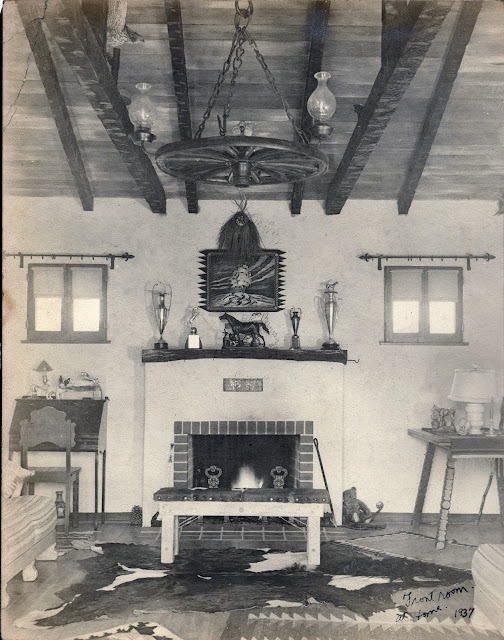%20El%20Rancho%20Poco%20living%20room.jpg) |
| An interior view of El Rancho Poco's "front room" showed its rustic Western decor, including a chandelier made from a wagon wheel and a hide on the floor. |
 |
The El Rancho Poco sign advertised "Morgan Horses,
Black & White Pinto and Morgan Stud Services" |
There, Merle bred, raised, and sold Pinto and Morgan horses and
operated a tractor landscaping and grading business. His clients for the latter
included the City of Monrovia and the school district.
 |
| Merle on his tractor, mid-1930s. |
Merle started with 30 acres, and it wasn't unusual for him to have 30 to 50 horses on the property. By 1965, however, post-war land use was changing neighborhoods in the San Gabriel Valley, and El Rancho Poco had shrunk to an acre and a half. A feature story in the October 30, 1965 Monrovia News-Post was titled "Merle Little Raises Morgan Horses on the Last Ranch in Monrovia."
"A final bite at the last operating ranch within the city limits of Monrovia was just taken to make way for the Foothill Freeway," the article by Arlee Grubbs begins.
"El Rancho Poco now has been cut down to 1 1/2 acres...Through the years this has been whittled down to make way for Monrovia's industrial expansion and other improvements, including the freeway which made the final dent in the land area....
"The El Rancho Poco may be getting smaller, but it is still booming with activity and Merle intends to hold on to what land he has left now as long as possible. He is currently moving some of his stables to make way for the freeway.
"With the freeway next door it will put the fast, modern, high-powered automobile running right over the heads of the transportation that built the west."
By 1969, Merle and Edna May had completed their move to a horse property on Lemon Avenue in nearby Bradbury, farther away from the "improvements" brought by changing land use.
Even though we can't go back to the days when horses were such a common feature in everyday life, we can learn from the way Merle Little played to his strengths, using the tools he had available -- horses, tractors, skillful hands, and volunteer community involvement -- to make Monrovia and Duarte better places to live.
Connecting People and Communities Through Horses: Merle’s public life was centered around his
horses. While still in high school, he made his own hand-carved silver-mounted
saddle, bridle, and chaps, with which he rode for many years. (They are now
part of the collection of the Santa Ynez, California Historical Museum.)
 |
| Merle Little and Thunder in the 1930s, probably on a street in Monrovia. |
As a young
adult during the Great Depression, Merle coordinated equestrian events to
benefit local charities. He was in charge of horse-related activities at Monrovia Days for several years.
 |
| Monrovia News-Post, May 15, 1934 |
 |
Merle coordinated the Monrovia Day horse show in 1935.
More than 400 horses and riders took part. |
Beginning in the 1930s, Merle took part in more than 20 Tournament of Roses Parades in Pasadena, often with friends and family members.
 |
| Merle Little and his Pinto gelding Thunder, at the 1932 Tournament of Roses Parade. The pair won a prize that year. |
 |
| The Little family and four of their Morgan horses prepared for the 1949 Tournament of Roses Parade. |
Merle also owned a collection of horse-drawn vehicles, including a stagecoach and a surrey, which he exhibited at horse shows and drove in parades and other special events.
 |
Merle with his "Arrow Rock Stage Line" stagecoach, which he converted from a buckboard wagon.
|
 |
| Merle's "surrey with the fringe on top," drawn by two of his Morgan mares, Santa Ynez and Anita Belle Gift. |
Merle worked on planning committees for fire prevention strategies and the development of a network of bridle trails in the San Gabriel Valley. He belonged to several riding groups, including the El
Rodeo Club in Orange County.
In the late 1930s, Merle fell in love with Morgan horses and started purchasing stallions and mares for a breeding program at El Rancho Poco.
 |
| Merle with two of his earliest Morgans, Sun Down Morgan (left) and Senor Morgan (right). |
In 1948, Merle acquired perhaps his best-known horse, Lippitt Morman, from Central California's legendary Morgan breeder Roland Hill. Hill had acquired the stallion from W. A. LeBoeuf, who had ridden him to victory in an grueling annual hundred-mile trail ride in Vermont in 1946. |
| The chestnut 1939 Morgan stallion Lippitt Morman made international news in the equestrian community when he carried his then-owner W. A. LeBoeuf to victory in the 1946 hundred-mile trail ride in Vermont. His name was wordplay, using the names of his sire, Mansfield and his dam, Lippitt Kate Moro. |
Merle and Lippitt Morman became a regular feature at Southern California parades and horse shows. The stallion even accompanied the Little family on horseback riding vacations.
 |
| Merle Little and Lippitt Morman representing LA County Sheriff's Posse #5 at a parade. |
A portrait of Lippitt Morman with Merle appeared next to his entry in the 1957 Monrovia Duarte Blue Book. Needless to say, "Lippitt" (as the family called him) was the only equine pictured in the publication. The picture underscores just how closely Merle was associated with horses in the community.
A son of Lippitt Morman, Boss Man Morman, made international news when he was selected to play the part of the Wells Fargo Wagon horse in the first national touring company production of the Meredith Willson's Broadway hit "The Music Man" from 1958 to 1962. His co-stars were Forrest Tucker, who played Professor Harold Hill, and Joan Weldon, who played Marian Paroo the librarian.
 |
| "Boss Man" in harness in front of the Philharmonic Auditorium in Los Angeles, where the national tour of "The Music Man" started in 1958. |
Meanwhile, Merle's other Morgans continue to rack up horse show wins and take part in community life. Newspaper and magazine articles credited Merle and his Pintos and Morgans with winning 500 or more awards at horse shows and parades throughout Southern California.
 |
| Merle with a few of his horse show awards, circa 1955. |
Equestrian Community: Merle had connections to several cowboy
entertainers, including Hoot Gibson, Tom Mix, and Allan “Rocky” Lane, who
played Red Ryder in “B” Westerns. He reportedly loaned horses to the film
industry.
 |
The black Morgan stallion Anndy Pershing, whose stage names
were "Thunder" and "Black Jack," with his person, cowboy actor Allan "Rocky" Lane. |
 |
Merle and his friend Montie Montana. The pair took part
in countless equestrian events together from the 1930s to the 1960s. |
In the late 1930s through early ‘40s, Merle was part of the Rancheros Visitadores, a group of businessmen and celebrities who conduct annual trail rides in Santa Barbara County.
 |
Merle, second from right, took part in the 1938 Rancheros Visitadores
ride through Santa Barbara County. |
 |
| Monrovia News-Post, December 8, 1941 |
On Horseback at Home in Wartime: On the home front during World War II, Merle served on the Defense Committee for Duarte, and as an
Auxiliary Military Policeman, working as a guard in a defense plant.
In 1943,
he joined Sheriff Eugene Biscailuz’s Los Angeles County Sheriff’s Posse under
the Office of Civil Defense. The Posse conducted search-and-rescue operations
including the horseback rescue of victims of the massive Tujunga Canyon flood in 1943. It also promoted the purchase of war bonds and stamps at fundraising events.
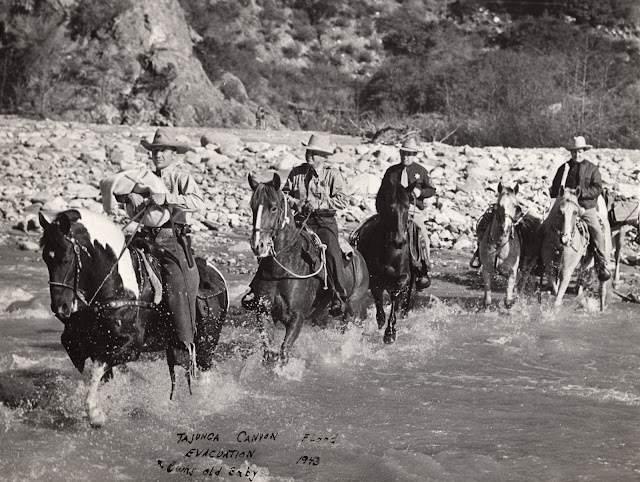%20Tesoro%20search%20and%20rescue%20flood.jpg) |
Merle Little, on his Pinto stallion Tesoro, helps evacuate an infant
from the Tujunga Canyon flood in 1943. |
It was important to keep a sense of community during the war. In 1944, Merle and one of his "trick mules" entertained community members at a supper at Monrovia Presbyterian Church.
.jpg) |
| Merle and one of his "trick mules," Aimee. |
Merle and Edna May hosted Thanksgiving dinner for 18 people at El Rancho Poco that year, including some local residents who had family members serving overseas.
As the war finally wound to a close, in August 1945, Merle became one of the founding members of the Morgan Horse Association of the West. The group sometimes met at El Rancho Poco, and boasted more than 70 members from several Western US states. It commissioned artist Gladys Brown Edwards to create a "Parade Morgan" horse design wearing Western tack, in metal, that could be used either as a bookend or a horse show trophy.
 |
| The "Parade Morgan" design by Gladys Brown Edwards could be used as a bookend or mounted on a wooden base as a horse show trophy. The example on the right was won by Merle's Morgan stallion Sun Down Morgan in 1947. |
After the war, as Southern California’s
population increased, so did interest in owning and riding horses for
recreation. By 1949, there were as many as 75,000 privately-owned horses in Los
Angeles County alone. In 1953, 1954, and 1955, Merle was one of several local ranchers who took part in Light Horse Judging Schools at California Polytechnic College on the old Kellogg Ranch property in Pomona.
 |
| Merle exhibits four of his Morgan mares at the 1953 Light Horse Judging School, sponsored by Western Livestock Journal magazine and California State Polytechnic College, Kellogg-Voorhis Campus, in Pomona. |
In 1954, Merle became a founding member of the Monrovia Mounted Police, an auxiliary of the Monrovia Police Department. They took part in equestrian events and parades throughout Southern California, including Monrovia Day and the Los Angeles County Fair in Pomona.
 |
| Merle Little and his Morgan stallion Lippitt Morman, second from left, holding the American flag, with other members of the Monrovia Mounted Police in the mid-1950s. |
Over the years, El Rancho Poco had become a destination for San Gabriel valley residents looking to take riding lessons or buy a horse. Local schoolchildren visited the ranch and learned to work with horses, sometimes through the Duarte 4-H Club.
.jpg) |
| Marlene (center) and Donnette (right) Little ride horseback with an unidentified friend at El Rancho Poco. |
Community organizations also used El Rancho Poco as a meeting place, including the Monrovia Day Roundup Association and the Duarte Fiesta Committee. |
| Monrovia News-Post, December 1, 1965 |
Equine Artists and Photographers:
Merle’s life with horses brought him in touch with several Southern
California-based equine artists.
As mentioned above, Merle and the Morgan Horse Club of the West hired artist and author Gladys
Brown Edwards to design a three-dimensional Morgan horse bookend/trophy in
Western Parade tack. (Related correspondence is part of the Cecil and Gladys
Brown Edwards Papers at the W. K. Kellogg Arabian Horse Library.) She moved to Monrovia for a time in the mid-1950s, where she raised champion Airedale Terriers.
 |
| Artist Gladys Brown Edwards (1908-1989) lived in Monrovia during the mid-1950s. |
In the early
1950s, Merle met equine artist Maureen May Love (1922-2004), a
designer for the Monrovia-based California pottery Hagen-Renaker, Inc. Although she designed many kinds of animals for H-R, Maureen is best known for her horse sculptures for the company. And many of those figurines were inspired by Merle Little's horses.  |
| Hagen-Renaker 7" ceramic Morgan stallion, inspired by Lippitt Morman. |
 |
Maureen Love sketched horses all over Southern California, then turned them into three-dimensional ceramic designs.
|
 |
| Sketch of a mare and foal by Maureen Love, sold on eBay by her estate in 2012. Source: Hagen-Renaker Online Museum. |
Maureen
made many trips to El Rancho Poco with her art supplies, spending hours in the
pasture and paddock making sketches and pastel drawings of the horses on the
property.
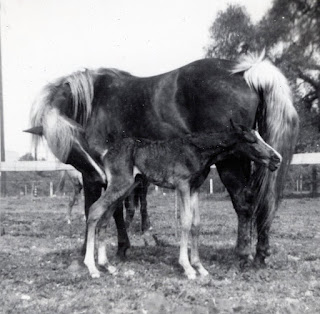.jpg) |
| Merle's Morgan mare Betty Joaquin with her foal, Tuffy Morgan. |
%20Merle%20Nancy%20Tony1.JPG) |
| Hagen-Renaker Morgan mare "Nancy" and foal "Tony," circa 1954. |
Photographer John Williamson documented life at El Rancho Poco in the 1940s and early 1950s. This portrait of Lippitt Morman appeared in flyers and magazine advertisements. Williamson was one of cereal magnate W. K. Kellogg's grandsons.
Duarte resident Barbara Chase painted a portrait of Lippitt Morman, inspired by Williamson's photograph. Local newspapers documented her work as an equine artist.
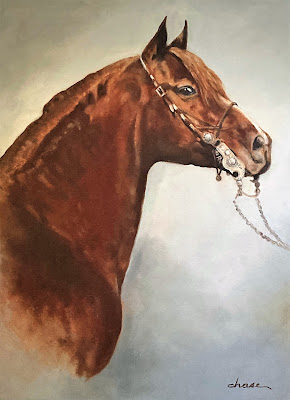%20Lippitt%20portrait.JPG) |
Lippitt Morman, by Barbara Chase
|
Death and Legacy: Merle continued to be active in civic
affairs and local equestrian activities until shortly before his death on
October 30, 1975. Newspaper columnist Clarence Desmond remembered:“For years, Merle had owned and operated El
Rancho Poco on South Mountain Avenue, and here were to be found many relics of
the Old West…. Merle also conducted a grading business and did much work for
the schools and the city. And he did even more work which was donated, for he
could never refuse contributing himself…to any worthy cause that needed
assistance that only he could afford.
“The number of friends that Merle had in
Monrovia was without limit, and his warmth and understanding, his willingness
to listen to the problems of others and his deep concern for his city and its
citizens made all this easy to understand…
“His trademarks were integrity, concern for
others, love of his family and an abiding faith in the destiny of his city and
its citizens.”
 |
| Merle Little feeds Morgan mares at El Rancho Poco. |
El Rancho Poco is gone, but Merle Little's legacy as a part of Monrovia and Duarte's community life is well-documented, not only by published reports about his work, but also by the many items he collected and left in his estate.
Sources:
Davis,
Charles F. and Ellavera Nelson Davis, Monrovia-Duarte Community Book.
Monrovia, California: Arthur H. Cawston, 1957.
Knowles,
Frederick C. Los Angeles County Horseman’s Survey and Directory, 1949-50 Edition.
Pasadena: California Horsemans’ Surveys (no date).
McDaniel,
Don. “Merle H. Little: The Man and His Horses.” The Morgan Horse
magazine, April 2009.
Vernon,
Charles Clark. “A History of the San Gabriel Mountains.” Historical Society
of Southern California, Vol. 38, No. 4 (1956).
Interviews
by Teresa Rogers with Marlene Willett, Donnette Peterson, and Don McDaniel.
Many
articles in the Duarte Star-Tribune, Monrovia News-Post, Pasadena
Independent, Pomona Progress-Bulletin, Los Angeles Times, Van Nuys News and
Valley Green Sheet newspapers; Western Livestock Journal, Western
Horseman, The Morgan Horse, and other magazines.
* * *
I have spent several years writing about Merle Little and his horses. Here are some links, for more information:
Lippitt Morman:
https://californiahorsehistory.blogspot.com/2020/04/lippitt-morman.html
https://californiahorsehistory.blogspot.com/2022/08/portraits-of-lippitt-morman-by.html
Gladys Brown Edwards' "Parade Morgan" design:
https://californiahorsehistory.blogspot.com/2021/04/all-together-now-parade-morgan-bookends.html
https://californiahorsehistory.blogspot.com/2022/07/sun-downs-morgan-horse-club-of-west.html
Merle's silver-mounted tack:
https://californiahorsehistory.blogspot.com/2023/05/saddling-up-in-santa-ynez-merle-h.html
El Rancho Poco:
https://californiahorsehistory.blogspot.com/2022/06/images-from-el-rancho-poco.html
San Gabriel Valley horse shows during the Great Depression:
https://californiahorsehistory.blogspot.com/2022/07/from-merle-little-archive-smaller.html
Labor Day equestrian events at the Rose Bowl:
https://californiahorsehistory.blogspot.com/2022/09/labor-day-equestrian-events-at-rose.html
Tournament of Roses Parade:
https://californiahorsehistory.blogspot.com/2023/01/california-morgans-love-parade-part-one.html
Azusa Golden Days:
https://californiahorsehistory.blogspot.com/2022/10/kaag-horse-trophy-from-azusa-golden.html
The Santa Barbara Fiesta:
https://californiahorsehistory.blogspot.com/2022/09/the-fiesta-invitations-in-mail-western.html
Rancheros Visitadores:
https://californiahorsehistory.blogspot.com/2024/05/merle-little-and-rancheros-visitadores.html
Boss Man Morman:
https://californiahorsehistory.blogspot.com/2024/06/boss-man-morman-morgan-horse-musical.html
The time I found Merle's collection of Morgan horse magazines on eBay, 40 years after he died:
https://californiahorsehistory.blogspot.com/2023/08/lost-but-now-found-horse-magazines-and.html
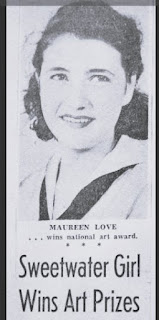




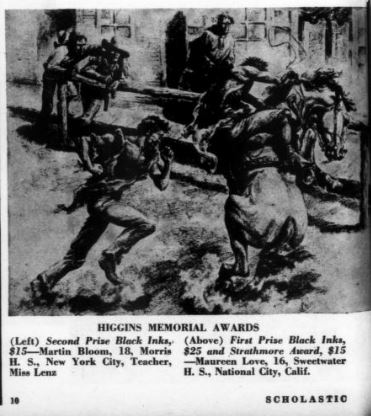

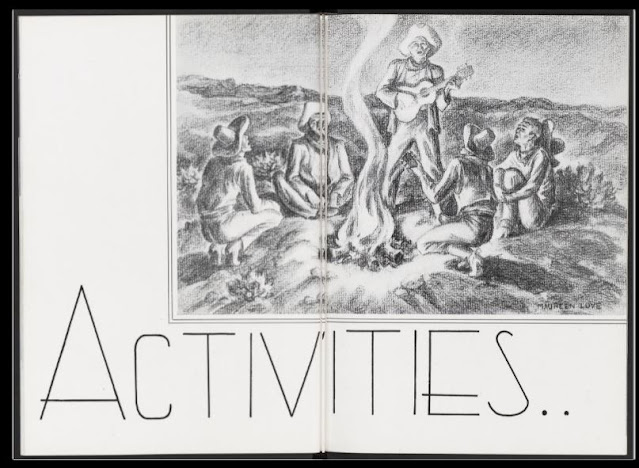


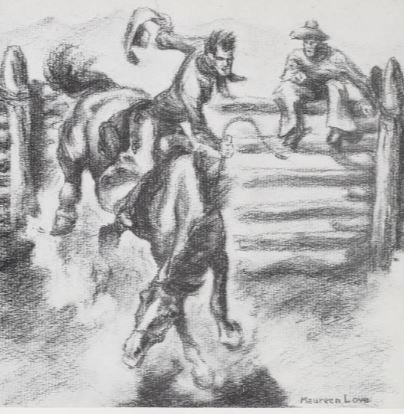


%20Lippitt%20parade%20flag.jpg)

.jpg)
%20Merle%20Eleanor%20toy%20horse.jpg)








.JPG)
%20El%20Rancho%20Poco%20living%20room.jpg)



















%20Tesoro%20search%20and%20rescue%20flood.jpg)
.jpg)



.jpg)





.jpg)
%20Merle%20Nancy%20Tony1.JPG)

%20Lippitt%20portrait.JPG)

